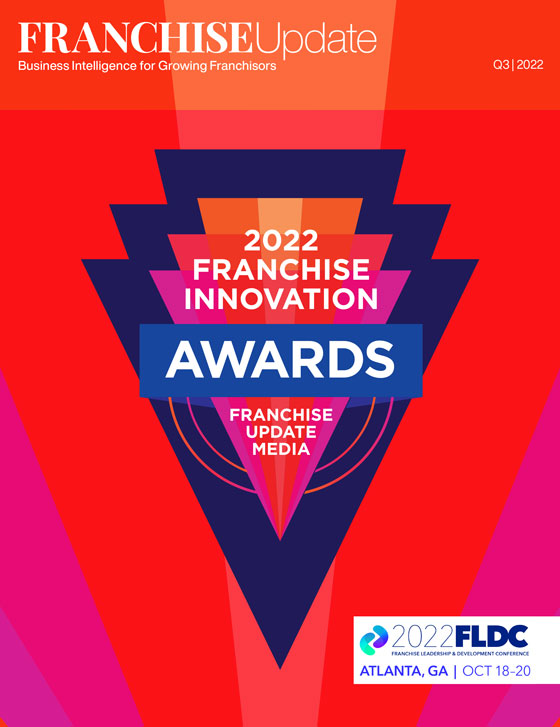Brand Consolidation: What's driving today's "mega" franchisors?

Large franchise platforms, “umbrella” companies offering multiple brands in related industries, have become an inescapable force in franchising. That’s not likely to change any time soon.
Authority Brands offers a comprehensive array of home services brands, from plumbing and pools to mosquito control and electrical repairs. Inspire Brands’ list of restaurants is large enough to satisfy most anyone’s appetite. Unleashed Brands, through its recent acquisitions, offers brand options that begin in childhood and continue through adulthood. And at the top of the multi-brand platform heap, sits Neighborly Brands, the world’s largest home services franchisor, with 29 brands and 5,000 franchises serving more than 12 million customers worldwide.
While the pandemic may have accelerated acquisitions, the trend is not new. Mike Bidwell, CEO of Neighborly, recalls a business school conference from 2014. Although Neighborly had partnered with private equity in 2003, a new element had emerged: the growth of the gig economy as a possible threat to the home services model. Bidwell examined the case study of his company created for the conference and discussed the situation with other CEOs.
“We thought we shouldn’t ignore what was happening,” he says. “It became clear that we had an opportunity to disrupt our own business and our own category. Out of that came the spark that maybe we ought to act.” They sure did.
The creation of these platforms, driven largely by private equity money, is sometimes “just aggregating brands, while others are looking to create highly synergystic platforms that make lives better for consumers,” he says. “Both are a set of brands with a common ownership in a highly integrated ecosystem.”
Making sense of this as a significant element of franchising is not difficult. “Private equity firms see a great opportunity to leverage what they’ve learned across brands to drive accelerated growth, as well as consolidating back-of-house infrastructures,” says Heather McLeod, CMO at Authority Brands. “Their backing and support, along with the capital they bring, has allowed many organizations to grow through the acquisition of complementary, usually consumer-focused brands.”
Authority Brands’ more than a dozen concepts include America’s Swimming Pool Co., Benjamin Franklin Plumbing, DoodyCalls, Homewatch CareGivers, Mister Sparky, Mosquito Squad, One Hour Heating & Air Conditioning, Stop Restoration, and The Cleaning Authority.
Efficiencies to scale
“Individual brands recognize that joining a large, established franchisor is appealing and will help them take advantage of shared services, including supply chain, digital, and marketing,” says Don Crocker, chief development officer at Inspire Brands.
For a smaller brand, acquisition can have definite advantages. “It allows for resources and staff that may not have been affordable for a brand if it remained on its own,” says McLeod. “For example, our marketing team has been able to add two data analytics roles that likely none of our brands as independent franchises would have had the budget to add.” When done right, she says, building teams of focused roles that can support franchise owners at scale makes the difference between a good company and a great one. “The operations side of the house will always be specialized, but there are significant opportunities in IT, HR, marketing, legal, and finance.”
Adding brands also can reduce jobs—in a good way. “You don’t need two accounting departments,” says Bidwell, “and you don’t need two CFOs.”
A large, multi-brand strategy supplies additional business advantages. “It allows a company to scale much more quickly than it would through traditional growth,” says Crocker. “This positions a brand well against those within its competitive set. And a franchisor may also look to add a new brand to scale in markets where it has few restaurants or locations. It’s all about making each brand stronger than it would be on its own.”
Inspire’s strategy of expansion through acquisition began in February 2018 with Arby’s acquisition of Buffalo Wild Wings and Rusty Taco. Since then, the company has added Baskin-Robbins, Dunkin’, Jimmy John’s, and Sonic Drive-In for a total of more than 3,400 franchises across 70 countries with 32,000 restaurants generating more than $30 billion in annual sales. That, says Crocker, makes Inspire one of the world’s largest restaurant brands, the second largest in North America in systemwide sales and locations, and a company well positioned for massive long-term growth.
Offering choices from a group of related franchise brands allows these platform companies to appeal to a wider audience—both consumers and prospective franchisees. “We like to use the game of monopoly as a metaphor,” says Michael Browning, founder and CEO of Unleashed Brands. “We can get them into the game with various game pieces. If they don’t have as much money to spend, we have brands that are lower in their entry cost and those that are higher, so they can get in depending on their budget.”
Strength in numbers
Stellar Service Brands, formed in April 2021 through the combination of Restoration 1 and bluefrog Plumbing + Drain, now also includes The Driveway Company and Softroc. “Franchisors are seeing the advantages of grouping different concepts together around industry segments, target customers, and even business models as a means to drive value creation and create complementary opportunities for franchisees,” says Sherry Rose, Stellar’s CEO.
Offering multiple brands also allows for a deeper understanding of what target customers want, she says. “The services that are provided create opportunities for franchisees to monetize leads and relationships that are part of their current operations.”
Other advantages emerge for platforms that follow a theme. Unleashed provides customers with a series of brands that can provide a long-lasting relationship. Children who start out at a Little Gym can proceed through a series of Unleashed brands all the way through to Class 101, a college planning brand. “When you share a similar customer you can serve that customer really well and bring that customer very synergistically aligned services. And when the customer wins, the business wins,” says Browning.
Browning understands that “each brand operates with a unique character and DNA, so it’s important to create standard processes, systems, and infrastructure while still maintaining those unique characters and DNA. It is definitely an art and a science.”
While the benefits are many, there can be disadvantages, too, cautions Rose. “Smaller brands can get lost as part of a large platform,” she says.
Constant diligence!
Transparency throughout the acquisition process is also crucial, says Browning. There must be a mutual evaluation process to help “close the gap between what we think we are buying and what they think they are selling. We don’t expect their core values to be ours, but we do look for people who are authentic, humble, confident in vision and mission, known for candor, who work well with a team, and who will work through the challenges.”
Other pitfalls can await. “You can get your assumption wrong about a business and how it fits into your business,” says Bidwell. The biggest challenge, he says, is integrating and blending the cultures of acquired businesses into Neighborly’s culture, even when there are thematic similarities.
A proper due diligence process, he says, allows a potential buyer to gain critical insights into a brand’s culture “to look for clues of their willingness to change and how enthusiastic they are about what your vision for the business is. You try to look beyond just the people at the table. Sometimes the people at the table aren’t staying. Talent is the single most important thing.”
Unleashed, says Browning, has an entire team that works on integration. “It’s a four-phase process over a matter of months and integration is never finished. We’re always trying to get better.” His experience with the details of acquisition has been intense and includes the integration of five franchises in 11 months. “Nothing is risk-free, but as long as we are using data to make tweaks to the business, we can make adjustments and course correct.”
Addressing these challenges successfully also requires having the right people in the right places to manage the complexity of owning a larger group of franchise brands. This includes the franchisor’s own team, from the C-suite to field operations, as well as the expertise and resources available from the private equity firm that invested in or acquired the platform company.
Are we done yet?
Time will tell whether the trend of ever-larger umbrella companies offering multiple brands is good or bad for franchising, or simply the inevitable next phase as franchising reaches another level of maturity.
“The platform trend is very positive for franchising,” says McLeod. “It brings brands together within a particular specialty and, through best practices and leveraging resources, makes them better than they would be if they operated independently. It ultimately offers a better future for franchisors and franchisees, as well as their private equity owners. It’s like a real-world roundtable where franchisors and franchisees learn better ways to operate and succeed. It’s a win-win for all stakeholders.”
Bidwell says the entry of private equity infuses franchising with a vigor that comes from the PE business model. “Private equity means more pressure to grow. It never gets lazy. It has a need to grow, to return capital to its investors.” Neighborly’s expansion has been supported by five private equity partners over the past two decades, he says, as those partners have sold their investments to other PE firms. Throughout Neighborly’s journey to its present size, he says, private equity has been an important partner in supporting the company’s growth.
That such acquisitions will continue seems certain. However, their number could be reduced for a variety of reasons. “The trend of companies acquiring additional franchise brands will likely slow as so many standalone brands are now part of platform companies,” says McLeod. “There are very few companies of significant size—100 or more units—that remain to be acquired. I think we will start to see platform companies look for small independent brands with one to five locations and then develop and franchise that business from the ground up.”
Bidwell sees another deterrent to the trend. “I think it may slow down a bit with rising interest rates,” he says.
“I don’t see it slowing down any time soon,” says Crocker. “The restaurant industry is trending in a positive direction as we progress through the pandemic. Sales are up, people are traveling again, and many are choosing to dine out or order through off-premise capabilities. With consumer demand continuing to rise, more brands will become attractive options to select franchisors.”
One economic reality will likely support the continuation of the acquisition trend, says Rose. “If there is true value creation realized by the franchisor, customer, and the individual franchisee, it will.”
Says Browning, “I do think this is the way of the future.”
Share this Feature
Recommended Reading:
FRANCHISE TOPICS
- Multi-Unit Franchising
- Get Started in Franchising
- Franchise Growth
- Franchise Operations
- Open New Units
- Franchise Leadership
- Franchise Marketing
- Technology
- Franchise Law
- Franchise Awards
- Franchise Rankings
- Franchise Trends
- Franchise Development
- Featured Franchise Stories
FEATURED IN

Franchise Update Magazine: Issue 3, 2022








 The franchise listed above are not related to or endorsed by Franchise Update or Franchise Update Media Group. We are not engaged in, supporting, or endorsing any specific franchise, business opportunity, company or individual. No statement in this site is to be construed as a recommendation. We encourage prospective franchise buyers to perform extensive due diligence when considering a franchise opportunity.
The franchise listed above are not related to or endorsed by Franchise Update or Franchise Update Media Group. We are not engaged in, supporting, or endorsing any specific franchise, business opportunity, company or individual. No statement in this site is to be construed as a recommendation. We encourage prospective franchise buyers to perform extensive due diligence when considering a franchise opportunity.